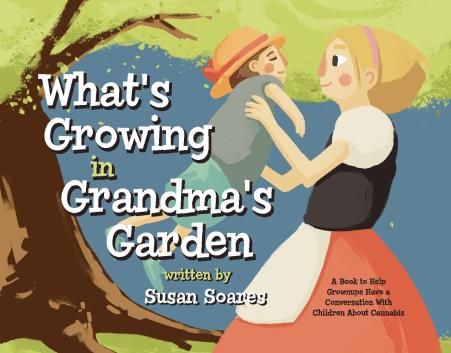
“What’s Growing in Grandma’s Garden” By Susan Soares
If you’re a parent who uses cannabis, it’s possible that at some point, you’ve experienced some uncertainty in how to talk to your children about it. But with a sweet and eloquent children’s story, What’s Growing in Grandma’s Garden, author Susan Soares has provided any parent who finds themselves in this situation with a helping hand.
“My Grandmother loves plants,” says a young boy, visiting his grandma’s sprawling garden. “She has lots of them. When I come over to her house we like to work together in her garden. She says that she has two green thumbs. They look normal to me.” This is sweet, because it sounds exactly like how a child would say it. When reading her words, I can almost hear my niece’s voice in my ear, trying to tell me about Grandma’s green thumbs.
The book is kind, and aesthetically inviting, looking like any children’s book you might see sitting on the shelf in a kindergarten classroom. You wouldn’t immediately know it had anything whatsoever to do with cannabis, save for a short description on the lower left-hand corner of the cover. In fact, the majority of the book’s words and illustrations are about the bond between a grandparent and grandchild, grown from a mutual love of nurturing a garden.
But in just 24 pages, Soares crafts a believable story that helps frame cannabis as a natural, healing medicine, even though it’s not necessarily for little kids. She tells her grandchild that he can look at the plant, but not touch it, and when he asks why, she explains in an honest and clear way, one that treats him with respect, while making it clear where the boundaries are.
“She tells him his brain is still growing just like the plants in the garden,” Soares writes, “and that he needs to feed it the right things to grow strong and fast like a supercomputer.”
It would be easy for Grandma to avoid answering the question—there probably isn’t a parent alive who doesn’t know the feeling of deftly tip-toeing around a question from a curious young mind, after all. But instead, she communicates her message in a way the boy can understand. She is patient, and even draws a brain so the child can picture what she is saying.
This story provides a fantastic model for parents to educate their kids about cannabis, and it gives them an easy way to understand it from their own perspective. Rather than fearing something they don’t know, or having to slowly cobble together an understanding of what cannabis is through their own experiences or through the media, Soares’ story empowers kids to be more informed. And in providing an easy entry point to a conversation that some might find awkward or uncertain, she provides a tremendous service to parents, as well.

